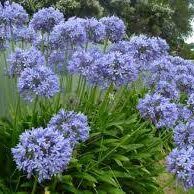Agapanthus Expanding Problems: Dirt, Sunshine, and Watering
Agapanthus Expanding Problems: Dirt, Sunshine, and Watering
Blog Article
Mastering the Art of Agapanthus Care: Crucial Steps for Healthy Growth and Lively Flowers
In the realm of horticulture, the farming of agapanthus stands as a rewarding endeavor for those who seek to support these sophisticated blooming plants. With their striking blooms and elegant foliage, agapanthus has captured the interest of garden enthusiasts worldwide. Nonetheless, accomplishing ideal development and vibrant blooms requires a nuanced strategy that encompasses different important steps. From picking the ideal selection to understanding pruning methods, the trip in the direction of cultivating growing agapanthus plants is complex and holds the vital to opening the full capacity of these organic gems.

Selecting the Right Agapanthus Variety

When choosing the appropriate Agapanthus variety for your garden, consider factors such as climate viability, flower shade, and development routine. In addition, take into consideration the climate in your region to guarantee the Agapanthus range you select can thrive in your particular problems. Comprehending the growth practice of various Agapanthus varieties is crucial for correct placement within your yard.
Ideal Planting Problems
Considering the optimum environmental demands is vital for effective Agapanthus cultivation. Agapanthus plants are delicate to chilly temperature levels and ought to be safeguarded from frost throughout winter season months.
To make certain healthy and balanced development and lively blooms, plant Agapanthus bulbs at a depth of concerning 2-4 inches and space them 8-12 inches apart. Adding raw material, such as garden compost, to the dirt can boost drain and fertility, advertising robust origin advancement. Mulching around the base of the plants assists maintain moisture and subdues weed development. Normal watering is crucial, particularly during the expanding period, to keep the soil regularly wet yet not waterlogged.
Watering and Feeding Tips
Preserving proper moisture degrees and offering crucial nutrients are essential components in the treatment regimen for Agapanthus plants. When it comes to sprinkling Agapanthus, it is crucial to strike an equilibrium. These plants like consistently wet dirt but are prone to root rot if overwatered.
Fertilizing Agapanthus is vital for advertising healthy growth and prolific blossoms. Use a balanced plant food, such as a 10-10-10 formula, in the very early springtime as new growth emerges. Repeat this application every 6-8 weeks throughout the growing period. Stay clear of extreme fertilization, as it can result in lush foliage at the expenditure of flowers. Always comply read the full info here with the maker's guidelines for appropriate dilution and application methods. By following these watering and feeding tips, you can guarantee your Agapanthus plants grow and create vivid, durable blossoms.
Pruning Methods for Agapanthus
Trimming Agapanthus plants at the proper times and with appropriate techniques is essential for maintaining their wellness and advertising ideal growth and flowering. The excellent time to prune Agapanthus is in late winter or very early spring prior to new development arises.
For flowered stems, wait up until the flowers have actually withered and then cut them back to the base. This not just tidies up the plant's look however also motivates the growth of new blossom buds. Deadheading invested flowers can likewise reroute the plant's power into producing even more blooms as opposed to setting seeds. However, if you desire to gather seeds for proliferation, leave some flowers to dry and mature on the plant.
Bear in mind to make use of clean, sharp tools to make accurate cuts and minimize the danger of presenting conditions. Agapanthus. Routine trimming will certainly assist maintain your Agapanthus looking neat and healthy and balanced while making sure a plentiful screen of attractive flowers
Managing Common Parasites and Diseases
After making sure correct trimming strategies for Agapanthus, it is important to deal with typical bugs and diseases that can influence the health and vitality of these plants. One typical insect that affects Agapanthus is the Agapanthus gall midget.
Another typical issue is fungal fallen leave place, which presents as dark sores on the fallen leaves. To stop fungal illness, make visit site certain excellent air blood circulation around the plants, stay clear of above watering, and remove any type of infected fallen leaves immediately. Furthermore, Agapanthus plants can struggle with root rot if they are planted in badly draining soil. To avoid this, plant Agapanthus in well-draining soil and prevent overwatering. By being alert and taking timely action versus diseases and pests, you can assist your Agapanthus plants thrive and generate dynamic blooms.
:strip_icc()/purple-agapanthus-4637b426-ba6babc24ea34dce9361ec746f6ebc63.jpg)
Final Thought
Finally, understanding the art of agapanthus treatment includes picking the best variety, offering optimal planting conditions, proper watering and feeding, suitable pruning techniques, and dealing with usual parasites and conditions. By complying with these important steps, you can make sure healthy development and dynamic blossoms for your agapanthus plants. Remember to routinely keep track of and preserve your plants to advertise their overall health and durability.
To make sure healthy growth and vivid blooms, plant Agapanthus light bulbs at a deepness of regarding 2-4 inches and room them 8-12 inches apart. By adhering to these watering and feeding suggestions, you can guarantee your Agapanthus plants grow and create vibrant, resilient flowers.
One common insect that influences Agapanthus is the Agapanthus gall midget. In addition, Agapanthus plants can experience from origin rot if they are planted in improperly draining soil. By following these crucial steps, you can ensure healthy read growth and vivid blossoms for your agapanthus plants.
Report this page